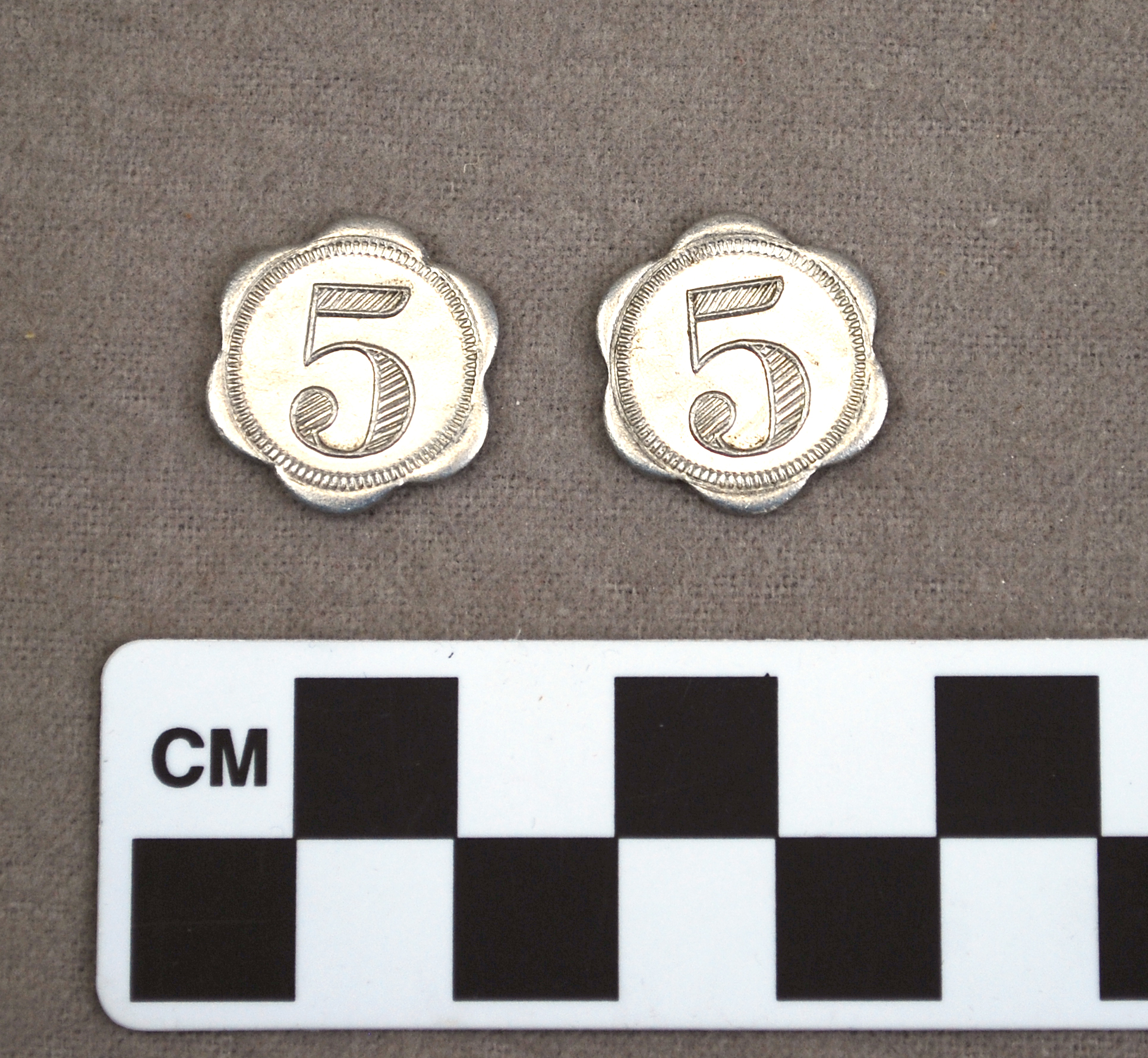These two silver colored metal coins were once valued at five cents at the Levine Brothers General Merchandise in Sealy, Texas. The unique scalloped edges and Levine Brothers print suggest these coins were developed specifically for the Levine Brothers store. Their store sold mostly general goods, and many early photos from the University of Texas at San Antonio digital collection document the Levine Brothers General Merchandise as a clothing store. In the small town of Sealy, Texas business and industry was not uncommon. Established in 1879 this 10.2 square mile town eventually became the home of the Sealy Mattress Company thanks to cotton gin builder Daniel Haynes. While the Levine Brothers General Merchandise may not have the recognizable name of Sealy Mattress, these coins in the UTSA Institute of Texan Cultures collection will maintain part of the history and legacy of the family store. These coins are unique for not only being of monetary value but also being commemorative in nature.
The commemorative coin revolution in the United States was sparked by Texas’ very own Lyndon B. Johnson. In 1966 Johnson signed the American Revolution Bicentennial Bill on the 200th anniversary of the American Revolution. This bill was introduced in an effort to revive patriotism and national spirit. The commemoration of the American Revolution was designed to remind Americans and the world of the values of the Revolution, a struggle for freedom and liberty. The Bicentennial Bill was written in an effort to build national unity through celebrations, education and the commemorative coin. The commission appointed by Lyndon B. Johnson was composed of members of Congress, Attorney Generals, Senators and even archivists from the Smithsonian Institute. The commission worked to organize national celebrations, educational programs to teach more about the American Revolution in schools and design commemorative goods.
Commemorative coins are still produced to this day. The United States Mint (U.S Mint) alongside Congress establish commemorative coins in an effort to pay tribute to significant events and influential people throughout history. The funds raised by the sale of commemorative coins goes directly into our national museums, monuments and memorials. The first establishment of a committee to develop a monetary system for the United States was in 1776. The U.S Mint was later founded in 1792 to produce and archive our nation’s coins. The U.S. Mint is also a historical archive for many documents and artifacts beyond just the official commemorative coins of the United States.
While not all coins are officially recognized as commemorative by the U.S Mint, many are made symbolic by their use. The Military Challenge coin is symbolic for many branches of our military. Each division, squadron and even rank within those branches can have their own unique coin. As history tells, the military coin came about during World War I when a soldier was taken captive by German forces and striped of all forms of identification, except for a military coin he wore in a pouch around his neck. He disguised himself and escaped, but ran into French military forces who thought he was an undercover member of the German army. Without anything to prove his identity as an American he was bound to be shot when he remembered the coin around his neck, the only thing the Germans forces left him with. The French recognized the emblem on his coin as American and they spared his life. Other stories date these military coins back to the Civil War as tokens taken by men as a reminder of the war. Yet, today these coins are much more than tokens, they are carried with pride and sometimes traded to one another or given as gifts. Here is where the “challenge” comes from, men and women in the military will sometimes “challenge” one another to present their coin to ensure they always have it with them. If you are unable to present your coin the punishment is often up to the challenger.
Now why would a store have their own coin made? These Levine Brothers coins may be commemorative but given the value they represent it is more likely they were used as store credit for purchasing. During severe economic crisis many countries resort to a rationing system. They consider the resources their country has and the size of the population to determine how much each family will be given. During World War II the United States took to rationing food, oil and even farm equipment. The majority of the resources they had were being funneled into the war, people, machinery, oil and anything needed overseas. Thus, families would receive booklets of stamps that they would use to get goods from local stores. Vendors would in turn use ration coins, or rather tokens, to payout the difference to families using ration stamps. Tokens hold another value all of their own, one beyond the commemorative or monetary. Tokens are place holders for a monetary value. It’s possible that these Levine Brothers coins were manufactured during a time of rationing for customers to use to buy merchandise. While they are not official commemorative coins they are housed in the museum collection as pieces of a small town Texas family history.
